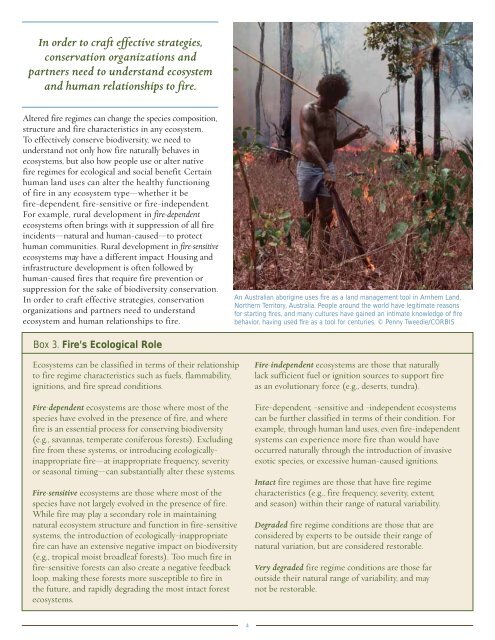Threats and Strategies for Global Biodiversity Conservation
Threats and Strategies for Global Biodiversity Conservation
Threats and Strategies for Global Biodiversity Conservation
You also want an ePaper? Increase the reach of your titles
YUMPU automatically turns print PDFs into web optimized ePapers that Google loves.
In order to craft effective strategies,conservation organizations <strong>and</strong>partners need to underst<strong>and</strong> ecosystem<strong>and</strong> human relationships to fire.Altered fire regimes can change the species composition,structure <strong>and</strong> fire characteristics in any ecosystem.To effectively conserve biodiversity, we need tounderst<strong>and</strong> not only how fire naturally behaves inecosystems, but also how people use or alter nativefire regimes <strong>for</strong> ecological <strong>and</strong> social benefit. Certainhuman l<strong>and</strong> uses can alter the healthy functioningof fire in any ecosystem type—whether it befire-dependent, fire-sensitive or fire-independent.For example, rural development in fire-dependentecosystems often brings with it suppression of all fireincidents—natural <strong>and</strong> human-caused—to protecthuman communities. Rural development in fire-sensitiveecosystems may have a different impact. Housing <strong>and</strong>infrastructure development is often followed byhuman-caused fires that require fire prevention orsuppression <strong>for</strong> the sake of biodiversity conservation.In order to craft effective strategies, conservationorganizations <strong>and</strong> partners need to underst<strong>and</strong>ecosystem <strong>and</strong> human relationships to fire.An Australian aborigine uses fire as a l<strong>and</strong> management tool in Arnhem L<strong>and</strong>,Northern Territory, Australia. People around the world have legitimate reasons<strong>for</strong> starting fires, <strong>and</strong> many cultures have gained an intimate knowledge of firebehavior, having used fire as a tool <strong>for</strong> centuries. © Penny Tweedie/CORBISBox 3. Fire’s Ecological RoleEcosystems can be classified in terms of their relationshipto fire regime characteristics such as fuels, flammability,ignitions, <strong>and</strong> fire spread conditions.Fire-dependent ecosystems are those where most of thespecies have evolved in the presence of fire, <strong>and</strong> wherefire is an essential process <strong>for</strong> conserving biodiversity(e.g., savannas, temperate coniferous <strong>for</strong>ests). Excludingfire from these systems, or introducing ecologicallyinappropriatefire—at inappropriate frequency, severityor seasonal timing—can substantially alter these systems.Fire-sensitive ecosystems are those where most of thespecies have not largely evolved in the presence of fire.While fire may play a secondary role in maintainingnatural ecosystem structure <strong>and</strong> function in fire-sensitivesystems, the introduction of ecologically-inappropriatefire can have an extensive negative impact on biodiversity(e.g., tropical moist broadleaf <strong>for</strong>ests). Too much fire infire-sensitive <strong>for</strong>ests can also create a negative feedbackloop, making these <strong>for</strong>ests more susceptible to fire inthe future, <strong>and</strong> rapidly degrading the most intact <strong>for</strong>estecosystems.Fire-independent ecosystems are those that naturallylack sufficient fuel or ignition sources to support fireas an evolutionary <strong>for</strong>ce (e.g., deserts, tundra).Fire-dependent, -sensitive <strong>and</strong> -independent ecosystemscan be further classified in terms of their condition. Forexample, through human l<strong>and</strong> uses, even fire-independentsystems can experience more fire than would haveoccurred naturally through the introduction of invasiveexotic species, or excessive human-caused ignitions.Intact fire regimes are those that have fire regimecharacteristics (e.g., fire frequency, severity, extent,<strong>and</strong> season) within their range of natural variability.Degraded fire regime conditions are those that areconsidered by experts to be outside their range ofnatural variation, but are considered restorable.Very degraded fire regime conditions are those faroutside their natural range of variability, <strong>and</strong> maynot be restorable.4
















